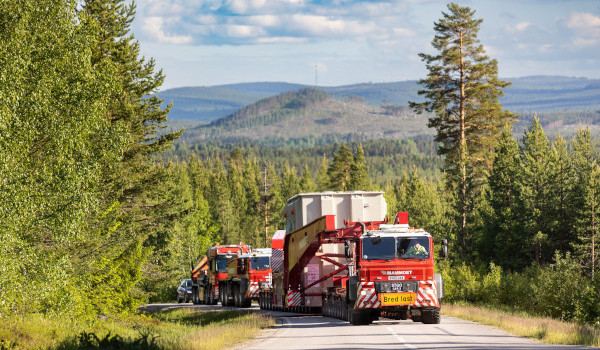390-Tonne Component Heaviest-Ever Transported on Swedish Roads
_1.jpeg)
Heavy-lift specialist Mammoet overcame some tough logistical challenges to successfully transport a 390-tonne transformer along an "unparalleled" 270-kilometre route to a wind energy project in the remote municipality of Ljusdal in central Sweden.
The hulking 750 mega volt ampere transformer – the heaviest component ever transported on Swedish roads – was carried through rugged terrain using Mammoet’s 400-tonne-capacity AL500 girder frame, a device designed to “cradle” very heavy cargo at a height just above ground level.
The frame was connected to two, 16-axle trailers, with a further eight axles added under the transformer when crossing some of the smaller bridges along the route to ensure the load was spread correctly.
The move, carried out for energy company Ellevio, was powered by a standard prime mover supporting two 700 horse-power Trojan trucks, Mammoet’s transport solution capable of hauling 500 tonnes up a 7 percent gradient, the Netherlands-based company said.
Mammoet, working alongside project forwarder Martin Bencher, said strong preparatory work was a “crucial first step” to ensure the cargo could move safely and smoothly.
 “The vast majority of roads in Sweden are not typically designed for heavy transport,” said Brendan James Daley, sales engineer at Mammoet Sweden. “Using planning work already undertaken by Martin Bencher we used our Route Survey Tool to identify what was needed to ensure roads could accommodate the transformer and the equipment transporting it.”
“The vast majority of roads in Sweden are not typically designed for heavy transport,” said Brendan James Daley, sales engineer at Mammoet Sweden. “Using planning work already undertaken by Martin Bencher we used our Route Survey Tool to identify what was needed to ensure roads could accommodate the transformer and the equipment transporting it.”
“Technical assessments of road and bridge strength, performed in partnership with Martin Bencher, showed that reinforcements were needed in many places to ensure the weights involved could be withstood. In other places, a 400mm depth of road had to be removed under some bridges to ensure sufficient headroom."
The transformer was first loaded at manufacturer Hitachi Energy’s facility at Ludvika, then carried 125 kilometres over two nights to Köping, from where Martin Bencher managed marine transport to Iggesund. Mammoet then transported the cargo the final 145 kilometres via land to the job site.
“Not only were the roads smaller in this less developed part of Sweden, but this stretch also contained four rail crossings where there were strict windows during which the load could pass, as well as five bridges where the additional eight axle lines were required,” Mammoet said.
“With transport only permitted to occur at night, this meant an additional six nights were needed to reach the final destination at Tovasen.” Once at Tovasen, a second Mammoet team handled the jacking and skidding of the transfer into position and ready for installation.
Check out below a video of the challenging move:
